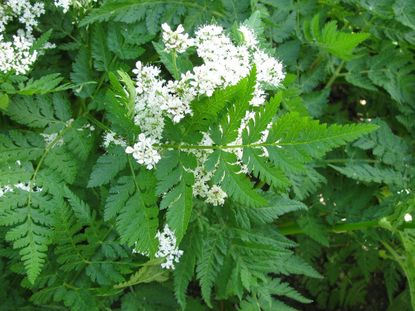Sweet Cicely Care – Tips On Growing Sweet Cicely Herbs


Sweet cicely (Myrrhis odorata) is an attractive, early blooming perennial herb with delicate, fern-like foliage, clusters of tiny white flowers, and a pleasant, anise-like aroma. Sweet cicely plants are known by a number of alternate names, including garden myrrh, fern-leaved chervil, shepherd’s needle, and sweet-scented myrrh. Interested in growing sweet cicely herbs? Read on to learn more.
Sweet Cicely Herb Uses
All parts of sweet cicely plants are edible. Although sweet cicely has been widely cultivated in past years and used to treat ailments such as stomachache and coughs, it isn’t commonly grown in most modern herb gardens. Many herbalists think sweet cicely deserves more attention, especially as a healthy, zero-calorie replacement for sugar. You can also cook the leaves like spinach, or add fresh leaves to salads, soups, or omelets. The stalks can be used much like celery, while the roots can be boiled or eaten raw. Many people say sweet cicely roots make flavorful wine. In the garden, sweet cicely plants are rich in nectar and highly valuable to bees and other beneficial insects. The plant is easy to dry and retains its sweet aroma even when dried.
How to Grow Sweet Cicely
Sweet cicely grows in USDA plant hardiness zones 3 through 7. The plants perform best in sun or part shade and moist, well-drained soil. An inch or 2 (2.5-5 cm.) of compost or well-rotted manure gets sweet cicely off to a good start. Plant sweet cicely seeds directly in the garden in autumn, as the seeds germinate in spring after several weeks of cold winter weather followed by warm temperatures. While it’s possible to plant seeds in spring, the seeds must first undergo a period of chilling in the refrigerator (a process known as stratification) before they will germinate. You can also divide mature plants in spring or autumn.
Sweet Cicely Care
Sweet cicely care is definitely not involved. Just water as needed to keep the soil moist, as sweet cicely generally needs about an inch (2.5 cm.) of water per week. Fertilize regularly. Use an organic fertilizer if you plan to use the herb in the kitchen. Otherwise, any general-purpose plant fertilizer is fine. While sweet cicely isn’t considered invasive, it can be quite aggressive. Remove the blooms before they set seed if you want to limit spread.
Gardening tips, videos, info and more delivered right to your inbox!
Sign up for the Gardening Know How newsletter today and receive a free download of our most popular eBook "How to Grow Delicious Tomatoes."

A Credentialed Garden Writer, Mary H. Dyer was with Gardening Know How in the very beginning, publishing articles as early as 2007.
-
 Urban Composting Guide: How To Compost In The Middle Of The City
Urban Composting Guide: How To Compost In The Middle Of The CityUrban composting does not have to be daunting. You can compost in the city, and maybe even try some urban worm composting!
By Mary Ellen Ellis
-
 Shrub Diseases And Pests To Watch Out For
Shrub Diseases And Pests To Watch Out ForShrub diseases and pests can be challenging. Learn how to recognize and eradicate them before they can present a danger to your plants.
By Susan Albert